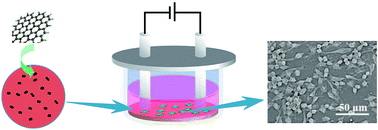A study on graphene composites for peripheral nerve injury repair under electrical stimulation
Abstract
Electrical stimulation (ES) provides an effective alternative to peripheral nerve repair via conductive scaffolds. The aim of the present study is to investigate a graphene (GR)/thermoplastic polyurethane (TPU) composite for the repair of peripheral nerve injury under ES. To this end, conductive composite membranes were fabricated by blending GR (2, 4 and 6 wt%) with TPU. GR maintains its own structure in the composite and enhances the mechanical and electrical properties of the composite. The composites with excellent biocompatibility had a hemolysis rate of less than 5%. As a result, the 4GR–TPU (4 wt% GR) sample with enhanced mechanical properties possessed the highest conductivity value of 33.45 ± 0.78 S m−1. Compared with the non-conductive sample, 4GR–TPU was favorable for the viability of Schwann cells (SCs) under ES. When different voltages of ES were applied, a direct current of 10 mV was more suitable for the growth and proliferation of SCs. This study provides beneficial information for peripheral nerve repair via ES.



 Please wait while we load your content...
Please wait while we load your content...